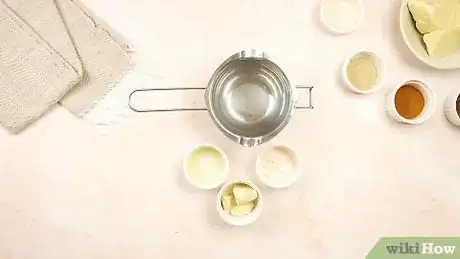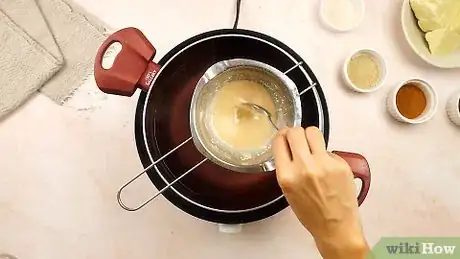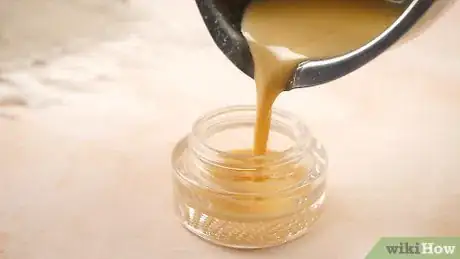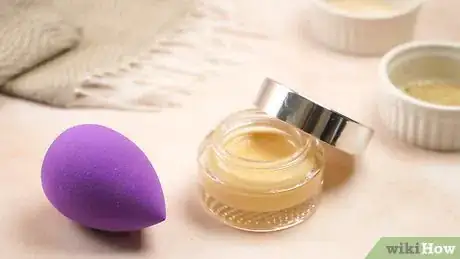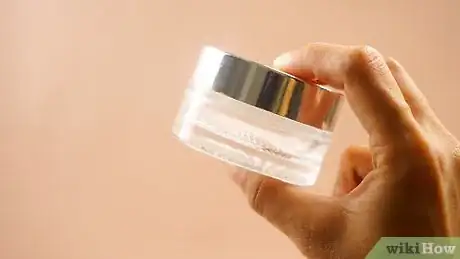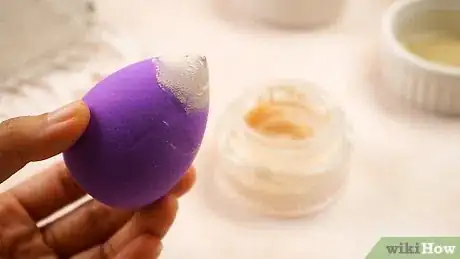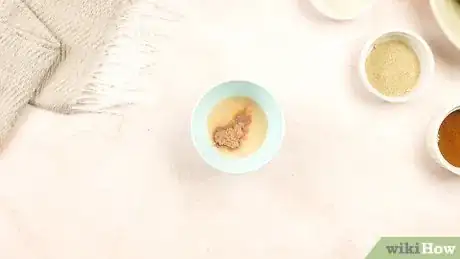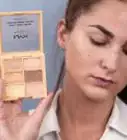This article was co-authored by Shara Strand and by wikiHow staff writer, Amber Crain. Shara Strand is a Makeup Artist and the Founder of Shara Makeup Studio, a makeup and image consulting studio based in New York City. She has over 15 years of image and makeup consulting experience including working as a regional artist for Bare Escentuals and Estee Lauder, Saks 5th Avenue, Bloomingdales, and Bergdorf Goodman. Her work has been featured in WNBC, Fox 5, Direct TV ABC morning news, and Hamptons Magazine. She is the creator of Shara Cosmetics and is a two time Billboard charted singer. She holds a BFA from New York University.
This article has been viewed 309,296 times.
Liquid foundation is a product that most makeup enthusiasts cannot live without. Unfortunately, department store and makeup counter versions are very expensive, and even the drugstore versions have become pretty pricey. Additionally, many commercial liquid foundations contain harmful ingredients that many people want to avoid. Luckily, with a few basic and inexpensive ingredients, you can make your own liquid foundation at home! Even better, making your own foundation allows you to customize the shade and coverage level.
Steps
Using Shea Butter, Jojoba Oil, and Loose Mineral Powder
-
1Add shea butter, jojoba oil, and powder to a double boiler. This mixture is ideal for dry skin types because of the moisturizing ingredients it contains. Measure out 1/2 teaspoon of shea butter, 1/2 teaspoon of jojoba oil, and 1 teaspoon of loose powder mineral makeup. Place all three on a double boiler on your stove.
-
2Turn the heat on medium-low. Warm the ingredients gently and stir the mixture occasionally. Continue heating until the shea butter melts. Turn off the burner and remove from heat.Advertisement
-
3Stir well and pour the mixture into an airtight container. Use a whisk or spoon the fully incorporate the ingredients. The texture should be smooth, with a consistent color. Pour the makeup into a clean container with an airtight lid. A small Tupperware container or an empty foundation bottle would work great.
- Don't put the lid on until the foundation cools off completely.
- This foundation will remain a pourable liquid as long as it's at room temperature.
-
4Allow the makeup to cool before applying it. Do not apply the warm makeup; let it cool off first. Use a regular makeup sponge to apply it like you would any other foundation. This recipe will yield a few weeks' worth of foundation, give or take, depending on how much you use daily.
Using Moisturizer and Powder Foundation
-
1Find a small container to use as a mixing palette. It's best to mix up a fresh batch of liquid foundation every day, or at least until you find your perfect ratio of ingredients. Start off using something small as your mixing palette, like a contact lens case or empty lip balm pot.
- If there are any leftovers, you can cap the container and use the rest for touch-ups throughout the day. Rinse it out and start fresh the next day!
-
2Sprinkle your powder foundation into the container. Start out with a couple of pinches of the powder. You're making a small batch for 1-2 applications, so keep that in mind. For example, if you're using a contact lens case, you would sprinkle just enough to lightly cover the bottom of one side of the case. You can always adjust or add more later![1]
- Use a plastic spoon or wooden spatula to transfer the powder into the container. Don't touch the makeup with your fingers because the oils on your fingers can affect the color of the makeup.
-
3Add an equal amount of your face moisturizer to the container.[2] Facial moisturizer is formulated to be gentle on your face. Don't use body lotion or anything other than your facial moisturizer for this or you may end up with clogged pores and breakouts.[3]
- If you break out easily, use an oil-free moisturizer.
-
4Mix the two ingredients together with a small fork or whisk. Stir the moisturizer and powder foundation until fully incorporated. The texture should be smooth, with no clumps of powder.[4]
-
5Test it out on your wrist or jaw line to determine coverage. Mixing equal parts moisturizer and powder will result in a medium coverage foundation. If you have fairly normal skin and don't have a lot to cover up, medium coverage is usually perfect. Pick up a little on your foundation brush and swipe it on the inside of your wrist or along your jaw line to check out how it looks and feels.[5]
- Be sure to rub it completely into your skin so you'll get an accurate idea of the what it looks like.
-
6Adjust the coverage as needed by adding more powder or lotion. Adding more moisturizer will result in a less concentrated foundation that provides light coverage. Adding more powder creates a concentrated foundation that provides full coverage. Add a very small amount at a time, mix, then test it out before adding more.[6]
-
7Apply it with a foundation brush or sponge as you normally would. Treat your DIY liquid foundation exactly the same as a store-bought variety when it comes to application. Once you've applied it and are happy with the coverage, put a lid on your container. Carry it with you during the day and use the leftover foundation for touch-ups (if needed).
-
8Make larger batches (optional). If you've perfected your mixture and love it, go ahead and make a larger batch! Use an old foundation bottle or a clean glass or plastic container to hold the batch. Be sure to shake it up well before each application.
- You can use a kitchen scale to ensure you are getting an even mix.
- Make sure that you don't make too much at once or it may spoil before you have a chance to use it.
Tinting Homemade Foundation
-
1Add a small amount of cocoa powder to darken the shade. Be sure to start with very small amounts at a time, mix thoroughly, and check the progress of the shade before adding more. Use a plastic spoon to mix thoroughly. Continue to add more until you're happy with the shade.[7]
- Cocoa powder darkens the shade neutrally without adding warm tones.
-
2Use cinnamon to add warmth and slightly darken the shade. If you have a warm skin tone, use powdered cinnamon with the cocoa to add warmth to your shade. Add a pinch of cinnamon at a time and mix thoroughly with a plastic spoon before adding more.[8]
- If you want to use your liquid foundation like a bronzer, extra cinnamon will give it that warm quality.
- You can also give nutmeg a try, as long as it's finely ground.[9]
-
3Experiment with other spices to alter the shade. Muira Puama bark, sassafras bark, cardamom powder, and sea buckthorn fruit powder are less common spices that can also be used to darken and customize the shade of your foundation. If you have access to any of these, give them a try! Next time you're at a health food store, pick up a couple and see how they work for you.[10]
-
4Add mica powder for a glowing bronzer effect. Choose mica powder in gold or bronze to create a beautiful sun-kissed glow. Sprinkle in a bit of mica powder, stir, and test the color. Tweak as needed, and continue mixing until you've created the glowing effect you want.[11]
- You can buy mica powders at beauty supply stores or online. Always buy cosmetic grade mica powder.
- For a cool-toned glow, similar to a highlighter, use silver or pearl mica powder.
-
5Add zinc oxide to your foundation for sunscreen. Zinc oxide will add sun protection to your liquid foundation. Buy uncoated, non-nano, and non-micronized zinc oxide. Because zinc is a thick substance, it will up the coverage level of your makeup. It can also make your skin appear smooth and soft, lower inflammation, fight acne, and lock in moisture.
- Zinc oxide is safe to use on skin, but wear a dust mask and gloves when working with it. Inhaling the fine powder can cause an overdose, because the lungs trap the zinc oxide and then release it into the bloodstream.[12]
- 1 ounce (28g) of zinc oxide results in approximately SPF 20.[13]
- You may need to experiment a bit to find out how much zinc oxide you like in your recipe. Typically, it requires anywhere from 1 teaspoon to 4 teaspoons.[14]
Expert Q&A
Did you know you can get expert answers for this article?
Unlock expert answers by supporting wikiHow
-
QuestionWhat ingredients should you include in foundation?
 Shara StrandShara Strand is a Makeup Artist and the Founder of Shara Makeup Studio, a makeup and image consulting studio based in New York City. She has over 15 years of image and makeup consulting experience including working as a regional artist for Bare Escentuals and Estee Lauder, Saks 5th Avenue, Bloomingdales, and Bergdorf Goodman. Her work has been featured in WNBC, Fox 5, Direct TV ABC morning news, and Hamptons Magazine. She is the creator of Shara Cosmetics and is a two time Billboard charted singer. She holds a BFA from New York University.
Shara StrandShara Strand is a Makeup Artist and the Founder of Shara Makeup Studio, a makeup and image consulting studio based in New York City. She has over 15 years of image and makeup consulting experience including working as a regional artist for Bare Escentuals and Estee Lauder, Saks 5th Avenue, Bloomingdales, and Bergdorf Goodman. Her work has been featured in WNBC, Fox 5, Direct TV ABC morning news, and Hamptons Magazine. She is the creator of Shara Cosmetics and is a two time Billboard charted singer. She holds a BFA from New York University.
Makeup Artist
-
QuestionCan I use beeswax instead of emulsifying wax?
 Laura MartinLaura Martin is a Licensed Cosmetologist in Georgia. She has been a hair stylist since 2007 and a cosmetology teacher since 2013.
Laura MartinLaura Martin is a Licensed Cosmetologist in Georgia. She has been a hair stylist since 2007 and a cosmetology teacher since 2013.
Licensed Cosmetologist
-
QuestionCan you use coconut oil for lotion?
 Laura MartinLaura Martin is a Licensed Cosmetologist in Georgia. She has been a hair stylist since 2007 and a cosmetology teacher since 2013.
Laura MartinLaura Martin is a Licensed Cosmetologist in Georgia. She has been a hair stylist since 2007 and a cosmetology teacher since 2013.
Licensed Cosmetologist
Things You'll Need
Moisturizer and Powder Foundation version
- Powder foundation
- Face moisturizer
- Small container with a lid
- Small fork or whisk
- Foundation brush or sponge
Shea Butter, Jojoba Oil, and Loose Mineral Powder version
- Double boiler
- Shea butter
- Jojoba oil
- Loose mineral powder
- Spoon
- Container with airtight lid
- Foundation brush or sponge
Tinting
- Cocoa powder
- Cinnamon
- Nutmeg
- Mica powder
- Plastic Spoon
- Zinc Oxide powder
References
- ↑ https://www.youtube.com/watch?v=85WE8Q60HWE
- ↑ Shara Strand. Makeup Artist. Expert Interview. 14 April 2020.
- ↑ https://www.youtube.com/watch?v=85WE8Q60HWE
- ↑ https://www.youtube.com/watch?v=85WE8Q60HWE
- ↑ https://www.youtube.com/watch?v=85WE8Q60HWE
- ↑ https://www.youtube.com/watch?v=85WE8Q60HWE
- ↑ http://www.herbalmusings.com/diy-makeup---naturalfoundation-and-blush
- ↑ http://www.herbalmusings.com/diy-makeup---naturalfoundation-and-blush
- ↑ https://www.youtube.com/watch?v=0H-tQxIZOZM
- ↑ http://www.herbalmusings.com/diy-makeup---naturalfoundation-and-blush
- ↑ http://wellnessmama.com/27328/liquid-foundation-recipe/
- ↑ http://www.homemadehints.com/natural-sunscreen-recipe-zinc-oxide/
- ↑ http://www.homemadehints.com/natural-sunscreen-recipe-zinc-oxide/
- ↑ http://wellnessmama.com/27328/liquid-foundation-recipe/
About This Article
Before you make liquid foundation, find a very small container to mix single batches in, like an empty lip balm container. Put a couple pinches of powder foundation into that container and add an equal amount of face moisturizer. Mix the ingredients together with a small whisk and test its coverage on your wrist or jawline. Add more lotion to make the coverage lighter, or more powder to make it heavier. Finally, apply it with a brush or sponge. For advice from our Cosmetologist reviewer on making a different foundation and tinting it, read on!
